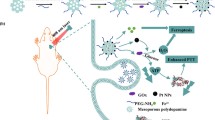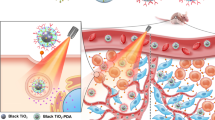Abstract
As nanomedicine-based clinical strategies have continued to develop, the possibility of combining chemotherapy and singlet oxygen-dependent photodynamic therapy (PDT) to treat pancreatic cancer (PaC) has emerged as a viable therapeutic modality. The efficacy of such an approach, however, is likely to be constrained by the mechanisms of drug release and tumor oxygen levels. In the present study, we developed an Fe(III)-complexed porous coordination network (PCN) which we then used to encapsulate PTX (PCN-Fe(III)-PTX) nanoparticles (NPs) in order to treat PaC via a combination of chemotherapy and PDT. The resultant NPs were able to release drug in response to both laser irradiation and pH changes to promote drug accumulation within tumors. Furthermore, through a Fe(III)-based Fenton-like reaction these NPs were able to convert H2O2 in the tumor site to O2, thereby regulating local hypoxic conditions and enhancing the efficacy of PDT approaches. Also these NPs were suitable for use as a T1-MRI weighted contrast agent, making them viable for monitoring therapeutic efficacy upon treatment. Our results in both cell line and animal models of PaC suggest that these NPs represent an ideal agent for mediating effective MRI-guided chemotherapy-PDT, giving them great promise for the clinical treatment of PaC.

Similar content being viewed by others
References
Bray, F.; Ferlay, J.; Soerjomataram, I.; Siegel, R. L.; Torre, L. A.; Jemal, A. Global cancer statistics 2018: GLOBOCAN estimates of incidence and mortality worldwide for 36 cancers in 185 countries. CA Cancer J. Clin.2016, 68, 394–424.
Kamisawa, T.; Wood, L. D.; Itoi, T.; Takaori, K. Pancreatic cancer. Lancet2016, 388, 73–85.
Witkowski, E. R.; Smith, J. K.; Tseng, J. F. Outcomes following resection of pancreatic cancer. J. Surg. Oncol.2013, 107, 97–103.
Von Hoff, D. D.; Ervin, T.; Arena, F. P.; Chiorean, E. G.; Infante, J.; Moore, M.; Seay, T.; Tjulandin, S. A.; Ma, W. W.; Saleh, M. N. et al. Increased survival in pancreatic cancer with nab-paclitaxel plus gemcitabine. N. Engl. J. Med.2013, 369, 1691–1703.
Gelderblom, H.; Verweij, J.; Nooter, K.; Sparreboom, A. Cremophor EL: The drawbacks and advantages of vehicle selection for drug formulation. Eur. J. Cancer2001, 37, 1590–1598.
Zhang, F. W.; Zhang, S. Y.; Pollack, S. F.; Li, R. C.; Gonzalez, A. M.; Fan, J. W.; Zou, J.; Leininger, S. E.; Pavía-Sanders, A.; Johnson, R. et al. Improving paclitaxel delivery: In vitro and in vivo characterization of PEGylated polyphosphoester-based nanocarriers. J. Am. Chem. Soc.2015, 137, 2056–2066.
Feng, Q. H.; Zhang, W. X.; Yang, X. M.; Li, Y. Z.; Hao, Y. W.; Zhang, H. L.; Hou, L.; Zhang, Z. Z. pH/ultrasound dual-responsive gas generator for ultrasound imaging-guided therapeutic inertial cavitation and sonodynamic therapy. Adv. Healthc. Mater.2018, 7, 1700957.
Chen, W. H.; Luo, G. F.; Vázquez-González, M.; Cazelles, R.; Sohn, Y. S.; Nechushtai, R.; Mandel, Y.; Willner, I. Glucose-responsive metal-organic-framework nanoparticles act as “smart” sense-and-treat carriers. ACS Nano2018, 12, 7538–7545.
Bansal, A.; Zhang, Y. Photocontrolled nanoparticle delivery systems for biomedical applications. Acc. Chem. Res.2014, 47, 3052–3060.
Lee, H.; Han, J.; Shin, H.; Han, H.; Na, K.; Kim, H. Combination of chemotherapy and photodynamic therapy for cancer treatment with sonoporation effects. J. Control. Release2018, 283, 190–199.
Jiang, Z. Q.; Wang, Y. J.; Sun, L.; Yuan, B.; Tian, Y. C.; Xiang, L. C.; Li, Y. Y.; Li, Y.; Li, J.; Wu, A. G. Dual ATP and pH responsive ZIF-90 nanosystem with favorable biocompatibility and facile postmodification improves therapeutic outcomes of triple negative breast cancer in vivo. Biomaterials2019, 197, 41–50.
Jiang, Z. Q.; Yuan, B.; Qiu, N. X.; Wang, Y. J.; Sun, L.; Wei, Z. N.; Li, Y. Y.; Zheng, J. J.; Jin, Y. H.; Li, Y. et al. Manganese-zeolitic imidazolate frameworks-90 with high blood circulation stability for MRI-guided tumor therapy. Nano-Micro Lett.2019, 11, 61.
Spring, B. Q.; Rizvi, I.; Xu, N.; Hasan, T. The role of photodynamic therapy in overcoming cancer drug resistance. Photochem. Photobiol. Sci.2015, 14, 1476–1491.
Zhao, Y. Y.; Wei, C. F.; Chen, X.; Liu, J. W.; Yu, Q. Q.; Liu, Y. N.; Liu, J. Drug delivery system based on near-infrared light-responsive molybdenum disulfide nanosheets controls the high-efficiency release of dexamethasone to inhibit inflammation and treat osteoarthritis. ACS Appl. Mater. Interfaces2019, 11, 11587–11601.
Bown, S. G.; Rogowska, A. Z.; Whitelaw, D. E.; Lees, W. R.; Lovat, L. B.; Ripley, P.; Jones, L.; Wyld, P.; Gillams, A.; Hatfield, A. W. R. Photodynamic therapy for cancer of the pancreas. Gut2002, 50, 549–557.
Hu, D. H.; Chen, Z. W.; Sheng, Z. H.; Gao, D. Y.; Yan, F.; Ma, T.; Zheng, H. R.; Hong, M. A catalase-loaded hierarchical zeolite as an implantable nanocapsule for ultrasound-guided oxygen self-sufficient photodynamic therapy against pancreatic cancer. Nanoscale2018, 10, 17283–17292.
Xu, R. Y.; Wang, Y. F.; Duan, X. P.; Lu, K. D.; Micheroni, D.; Hu, A. G.; Lin, W. B. Nanoscale metal-organic frameworks for ratiometric oxygen sensing in live cells. J. Am. Chem. Soc.2016, 138, 2158–2161.
Yang, G. B.; Xu, L. G.; Chao, Y.; Xu, J.; Sun, X. Q.; Wu, Y. F.; Peng, R.; Liu, Z. Hollow MnO2 as a tumor-microenvironment-responsive biodegradable nano-platform for combination therapy favoring antitumor immune responses. Nat. Commun.2017, 8, 902.
Bristow, R. G.; Hill, R. P. Hypoxia and metabolism. Hypoxia, DNA repair and genetic instability. Nat. Rev. Cancer2008, 8, 180–192.
Wang, D. D.; Wu, H. H.; Lim, W. Q.; Phua, S. Z. F.; Xu, P. P.; Chen, Q. W.; Guo, Z.; Zhao, Y. L. A mesoporous nanoenzyme derived from metal-organic frameworks with endogenous oxygen generation to alleviate tumor hypoxia for significantly enhanced photodynamic therapy. Adv. Mater.2019, 31, 1901893.
Tang, J. Q.; Zhou, H. G.; Hou, X. Y.; Wang, L. M.; Li, Y. X.; Pang, Y. Y.; Chen, C. Y.; Jiang, G.; Liu, Y. Q. Enhanced anti-tumor efficacy of temozolomide-loaded carboxylated poly(amido-amine) combined with photothermal/photodynamic therapy for melanoma treatment. Cancer Lett.2018, 423, 16–26.
You, Q.; Sun, Q.; Wang, J. P.; Tan, X. X.; Pang, X. J.; Liu, L.; Yu, M.; Tan, F. P.; Li, N. A single-light triggered and dual-imaging guided multifunctional platform for combined photothermal and photodynamic therapy based on TD-controlled and ICG-loaded CuS@mSiO2. Nanoscale2017, 9, 3784–3796.
Cheng, Y. H.; Cheng, H.; Jiang, C. X.; Qiu, X. F.; Wang, K. K.; Huan, W.; Yuan, A. H.; Wu, J. H.; Hu, Y. Q. Perfluorocarbon nanoparticles enhance reactive oxygen levels and tumour growth inhibition in photodynamic therapy. Nat. Commun.2015, 6, 8785.
Liu, L. H.; Zhang, Y. H.; Qiu, W. X.; Zhang, L.; Gao, F.; Li, B.; Xu, L.; Fan, J. X.; Li, Z. H.; Zhang, X. Z. Dual-stage light amplified photodynamic therapy against hypoxic tumor based on an O2 self-sufficient nanoplatform. Small2017, 13, 1701621.
McEwan, C.; Owen, J.; Stride, E.; Fowley, C.; Nesbitt, H.; Cochrane, D.; Coussios, C. C.; Borden, M.; Nomikou, N.; McHale, A. P. et al. Oxygen carrying microbubbles for enhanced sonodynamic therapy of hypoxic tumours. J. Control. Release2015, 203, 51–56.
Halliwell, B.; Clement, M. V.; Long, L. H. Hydrogen peroxide in the human body. FEBS Lett.2000, 486, 10–13.
Valko, M.; Izakovic, M.; Mazur, M.; Rhodes, C. J.; Telser, J. Role of oxygen radicals in DNA damage and cancer incidence. Mol. Cell. Biochem.2004, 266, 37–56.
Ma, Z. F.; Zhang, M. C.; Jia, X. D.; Bai, J.; Ruan, Y. D.; Wang, C.; Sun, X. P.; Jiang, X. E. FeIII-doped two-dimensional C3N4 nanofusiform: A new O2-evolving and mitochondria-targeting photodynamic agent for MRI and enhanced antitumor therapy. Small2016, 12, 5477–5487.
Zheng, D. W.; Li, B.; Li, C. X.; Fan, J. X.; Lei, Q.; Li, C.; Xu, Z. S.; Zhang, X. Z. Carbon-dot-decorated carbon nitride nanoparticles for enhanced photodynamic therapy against hypoxic tumor via water splitting. ACS Nano2016, 10, 8715–8722.
Pinto, S. M. A.; Calvete, M. J. F.; Ghica, M. E.; Soler, S.; Gallardo, I.; Pallier, A.; Laranjo, M. B.; Cardoso, A. M. S.; Castro, M. M. C. A.; Brett, C. M. A. et al. A biocompatible redox MRI probe based on a Mn(II)/Mn(III) porphyrin. Dalton Trans.2019, 48, 3249–3262.
Shen, Z. Y.; Song, J. B.; Yung, B. C.; Zhou, Z. J.; Wu, A. G.; Chen, X. Y. Emerging strategies of cancer therapy based on ferroptosis. Adv. Mater.2018, 30, 1704007.
Lan, G. X.; Ni, K. Y.; Xu, Z. W.; Veroneau, S. S.; Song, Y.; Lin, W. B. Nanoscale metal-organic framework overcomes hypoxia for photodynamic therapy primed cancer immunotherapy. J. Am. Chem. Soc.2018, 140, 5670–5673.
Wang, Y. J.; Wang, C.; Gong, C. Y.; Wang, Y. J.; Guo, G.; Luo, F.; Qian, Z. Y. Polysorbate 80 coated poly (ε-caprolactone)-poly (ethylene glycol)-poly (ε-caprolactone) micelles for paclitaxel delivery. Int. J. Pharm.2012, 434, 1–8.
Garvie, L. A. J.; Buseck, P. R. Ratios of ferrous to ferric iron from nanometre-sized areas in minerals. Nature1998, 396, 667–670.
Liu, C.; Luo, L. J.; Zeng, L. Y.; Xing, J.; Xia, Y. Z.; Sun, S.; Zhang, L. Y.; Yu, Z.; Yao, J. L.; Yu, Z. S. et al. Porous gold nanoshells on functional NH2-MOFs: Facile synthesis and designable platforms for cancer multiple therapy. Small2018, 14, 1801851.
Sukhorukov, G. B.; Antipov, A. A.; Voigt, A.; Donath, E.; Möhwald, H. pH-controlled macromolecule encapsulation in and release from polyelectrolyte multilayer nanocapsules. Macromol. Rapid Commun.2001, 22, 44–46.
Park, J.; Jiang, Q.; Feng, D. W.; Mao, L. Q.; Zhou, H. C. Size-controlled synthesis of porphyrinic metal-organic framework and functionalization for targeted photodynamic therapy. J. Am. Chem. Soc.2016, 138, 3518–3525.
Fan, L.; Zhao, S. S.; Jin, X.; Zhang, Y. S.; Song, C. J.; Wu, H. Synergistic chemo-photodynamic therapy by “big & small combo nanoparticles” sequential release system. Nanomed.: Nanotechnol., Biol. Med.2018, 14, 109–121.
Acknowledgements
This work was supported by the National Natural Science Foundation of China (Nos. 81527803, 81420108018, U1432114, 81550110258, 8161101589, 81650410654 and 31971292), National Key R&D Program of China (Nos. 2018YFC0115900 and 2018YFC0910601), Key Breakthrough Program of Chinese Academy of Sciences (No. KGZD-EW-T06), Zhejiang Science and Technology Project (No. 2019C03077), the Hundred Talents Program of Chinese Academy of Sciences (No. 2010-735), Youth Natural Science Fund Project of Zhejiang Province (No. LQ19H180004), Natural Science Fund Project of Ningbo City (No. 2018A610380), and Key Laboratory of Diagnosis and Treatment of Digestive System Tumors of Zhejiang Province (No. 2019E10020). We acknowledge Ruifen Zou for help in animal experiments, and Ting Xue for help of Material characterization.
Author information
Authors and Affiliations
Corresponding authors
Ethics declarations
The authors declare no competing financial interest.
Electronic Supplementary Material
12274_2019_2610_MOESM1_ESM.pdf
PCN-Fe(III)-PTX nanoparticles for MRI guided high efficiency chemo-photodynamic therapy in pancreatic cancer through alleviating tumor hypoxia
Rights and permissions
About this article
Cite this article
Zhang, T., Jiang, Z., Chen, L. et al. PCN-Fe(III)-PTX nanoparticles for MRI guided high efficiency chemo-photodynamic therapy in pancreatic cancer through alleviating tumor hypoxia. Nano Res. 13, 273–281 (2020). https://doi.org/10.1007/s12274-019-2610-6
Received:
Revised:
Accepted:
Published:
Issue Date:
DOI: https://doi.org/10.1007/s12274-019-2610-6




